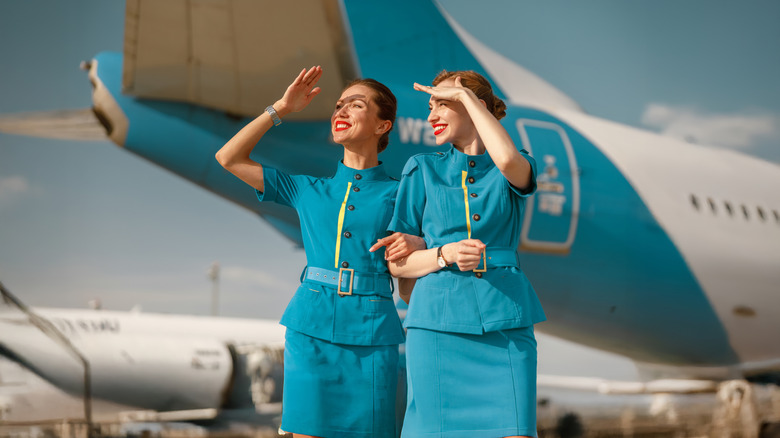The Odd But Practical Physical Requirement To Become A Flight Attendant For Some Airlines
When you imagine your average flight attendant, you might be visualizing a glamorous jet-setter, leisurely exploring countries all over the world. However, the reality is a little different — the hours can be long and the work challenging. And unfortunately, flight attendants' pay is not what you'd think it is, as they aren't compensated during boarding, delays, or between flights. Moreover, becoming a flight attendant is harder than you may expect, as airlines often require fluency in at least two languages, prior hospitality experience, and potentially a willingness to relocate. But beyond that, there's also a physical requirement — cabin crew must be within a specified minimum and maximum height. This standard may seem odd, as height isn't at all related to competency. However, there's a very practical reason behind the rule: safety.
As the role is carried out in a confined space, sometimes in very small aircraft, the maximum is in place to ensure staff can move around with ease and without injuring themselves. On the other hand, the minimum is in place so that they can reach the overhead bins independently. Contrary to popular belief, cabin crew are not required to help you lift and stow away your bags — this is one of the biggest misconceptions about flight attendants, and many of them hate when passengers make this request. That being said, most flight attendants will still help with this task, particularly for injured or elderly passengers. But more importantly, safety equipment is stored in these compartments, including fire extinguishers, medical kits, oxygen tanks, and other life-saving supplies. In an emergency, all crew members need to be able to access this equipment unassisted. The difference between life and death can be a matter of seconds, so staff cannot waste time waiting for a taller coworker to grab the necessary gear.
What are the actual height requirements for flight attendants?
Every airline has its own height regulations based on the specific aircraft it uses. The standards have a wide range — anywhere from a minimum of 4 feet, 11 inches to a maximum of 6 feet, 4 inches. QantasLink, an Australian airline, has one of the lowest minimums (just 5 feet), since it operates regional flights on smaller aircraft. Meanwhile, several European airlines, including Norwegian and Air Europa, require women to be at least 5 feet, 4 inches, and men to be 5 feet, 6 inches. KLM and Lufthansa have among the highest maximums, at 6 feet, 2 inches and 6 feet, 4 inches respectively.
You might be surprised to learn that certain airlines don't have a height requirement at all. Instead, these airlines assess the prospective flight attendant's ability to reach. This means that instead of checking whether applicants are above a certain line on a measuring stick, like they're children at an amusement park, they will conduct a reach test. For example, Cathay Pacific requires a minimum reach of 6 feet, 8 inches. Most airlines that carry out this assessment allow participants to stand on tiptoes.
Passing this test may seem like one of the most unusual rules for being a flight attendant. However, remember that safety is the number-one concern, and crew members simply need to demonstrate their ability to independently access overhead compartments. For applicants on the shorter side, this test is much fairer — reach is actually something that can be practiced and improved (unlike height). Although the recruitment processes may vary significantly across airlines, cabin crew are rigorously assessed before selection. Rest assured that they have met both the physical requirements and training standards of the carrier and are sure to keep you safe on the plane.

